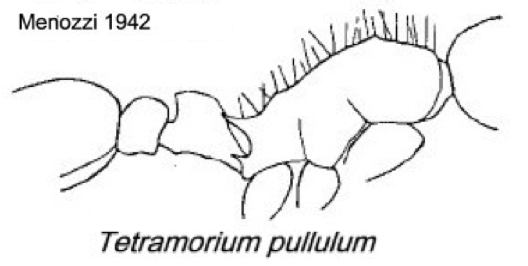Tetramorium pullulum Santschi
  Type location Zaïre (Tetramorium
guineense F. stirps pullulum n. st., Santschi, 1924b: 211,
illustrated, worker; but what must be the same specimen named as Xiphomyrmex
uelense by Santschi, 1935: 267; raised to species by Bolton, 1980:
273, not illustrated) collected at Haut Uelé, by L. Burgeon - see below Type location Zaïre (Tetramorium
guineense F. stirps pullulum n. st., Santschi, 1924b: 211,
illustrated, worker; but what must be the same specimen named as Xiphomyrmex
uelense by Santschi, 1935: 267; raised to species by Bolton, 1980:
273, not illustrated) collected at Haut Uelé, by L. Burgeon - see below
junior
synonym fernandensis (Tetramorium
fernandensis n. sp., Menozzi, 1942: 174, illustrated) from
Fernando
Po I., Moke, by H. Eidmann, xii.1939 - no images on Antweb (April 2015)
worker only described (see
Bolton, 1995). Bolton (1980) does not comment on this aberration of
naming, and Santschi (1935) describes the specimen without any hint of
having seen it previously  . .
|
 Santschi's
(1924b) description is at Santschi's
(1924b) description is at  . Santschi's (1935a) description of uelensis
is at . Santschi's (1935a) description of uelensis
is at  Menozzi's (1942)
description of fernandensis is at Menozzi's (1942)
description of fernandensis is at  Bolton's modern description (1980) is at Bolton's modern description (1980) is at  . .
|
 WORKER - TL
3.2-4.0 mm. Santschi's (1935) description was
- black, mandibles, antennae and tarsi brownish; anterior of tibiae
whitish. Area between frontal carinae stretching back to the posterior
angles of the head with five strong and spaced rugae, the median three
arising on the clypeus; the outer two close to the frontal carinae.
irregularly reticulate between the rugae; on the vertex a strong ruga
or transverse fold crosses from one frontal carina to the other. The
scape is smooth to the midpoint and then more or less reticulated. The
rugae of the head pass on to the dorsum of the thorax and pedicel,
somewhat more irregular and with spaces smooth. Between the pro and
mesonotum there is a strong transverse ridge; the centre of the
mesonotum and the sides of the thorax have clear spaces. The
postpetiole is more feebly scupltured than the petiole, and the gaster
is shiny with microscopic longitudinal rugulae. Pilosity erect,
brownish, quite long and abundant on the body; appendages with long
decumbent pubescence. WORKER - TL
3.2-4.0 mm. Santschi's (1935) description was
- black, mandibles, antennae and tarsi brownish; anterior of tibiae
whitish. Area between frontal carinae stretching back to the posterior
angles of the head with five strong and spaced rugae, the median three
arising on the clypeus; the outer two close to the frontal carinae.
irregularly reticulate between the rugae; on the vertex a strong ruga
or transverse fold crosses from one frontal carina to the other. The
scape is smooth to the midpoint and then more or less reticulated. The
rugae of the head pass on to the dorsum of the thorax and pedicel,
somewhat more irregular and with spaces smooth. Between the pro and
mesonotum there is a strong transverse ridge; the centre of the
mesonotum and the sides of the thorax have clear spaces. The
postpetiole is more feebly scupltured than the petiole, and the gaster
is shiny with microscopic longitudinal rugulae. Pilosity erect,
brownish, quite long and abundant on the body; appendages with long
decumbent pubescence.
Head rectangular, about one-fifth long than wide, anterior angles
dentate or sharp. Clypeus concave medially. Mandibles smooth, with
three apical teeth. The convex eyes occupy the median third of the
head. Scape reaching the occiput; mid-segments of funiculus transverse;
basal two segments of club slightly longer than wide but apical segment
as long as the other two together. Thorax straighter than head;
pronotum flat after the transverse ridge and mesonotum horizontal in
profile; propodeum dorsum oblique, spines robust, slightly divergent,
raised and slightly curved upwards; metasternal spines shorter. Petiole
node rectangular in profile, as high as long; postpetiole node also as
wide as long but about one-third larger than the petiole node;
posterior articulation thick. Gaster as long as the thorax.
Bolton (1980) reported other specimens from Zaïre,
Sudan, Uganda and Angola.
|
 The
photomontage of a worker from Kenya is collated
from http://www.antweb.org/specimen.do?name=casent0217223. The
photomontage of a worker from Kenya is collated
from http://www.antweb.org/specimen.do?name=casent0217223.
The holotype, to which this is identical, can be seen at http://www.antweb.org/specimen.do?name=casent0906124.
|
|